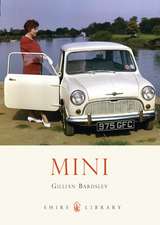Two Thousand Miles On An Automobile
Autor Arthur Jerome Eddyen Limba Engleză Paperback – 31 aug 2007
| Toate formatele și edițiile | Preț | Express |
|---|---|---|
| Paperback (2) | 98.72 lei 38-44 zile | |
| Echo Library – 31 aug 2007 | 98.72 lei 38-44 zile | |
| Applewood Books – 30 apr 2006 | 137.89 lei 6-8 săpt. |
Preț: 98.72 lei
Nou
Puncte Express: 148
Preț estimativ în valută:
18.89€ • 20.51$ • 15.87£
18.89€ • 20.51$ • 15.87£
Carte tipărită la comandă
Livrare economică 18-24 aprilie
Preluare comenzi: 021 569.72.76
Specificații
ISBN-13: 9781406850024
ISBN-10: 1406850020
Pagini: 164
Dimensiuni: 152 x 229 x 10 mm
Greutate: 0.25 kg
Editura: Echo Library
Colecția Echo Library
Locul publicării:United Kingdom
ISBN-10: 1406850020
Pagini: 164
Dimensiuni: 152 x 229 x 10 mm
Greutate: 0.25 kg
Editura: Echo Library
Colecția Echo Library
Locul publicării:United Kingdom
Extras
MAKING READY TO START The machine was just an ordinary twelve hundred dollar single-cylinder American machine, with neither improvements nor attachments to especially strengthen it for a long tour; and it had seen constant service since January without any return to the shop for repairs. The horse-power It was rated eight and one-half horse-power; but, as every one knows, American machines are overrated as a rule, while foreign machines are greatly underrated. A twelve horse-power American machine may mean not more than eight or ten; a twelve horse-power French machine, with its four cylinders, means not less than sixteen. The foreign manufacturer appreciates the advantage of having it said that his eight horse-power machine will run faster and climb better than the eight horsepower machine of a rival maker; hence the tendency to increase the power without changing the nominal rating. The American manufacturer caters to the demand of his customers for machines of high power by advancing the nominal rating quite beyond the power actually developed. But already things are changing here, and makers show a disposition to rate their machines low, for the sake of astonishing in performance. A man dislikes to admit his machine is rated at forty horse-power and to acknowledge defeat by a machine rated at twenty, when the truth is that each machine is probably about thirty. The tendency at the present moment is decidedly The French type towards the French type,--two or four cylinders placed in front. In the construction of racing-cars and high-speed machines for such roads as they have on the other side, we have much to learn from the French,--and we have been slow in learning it. The conceit of the American mechanic amounts often to blind stubbornness, but the ease with which the foreign machines have passed the American in all races on smooth roads has opened the eyes of our builders; the danger just now is that they will go to the other extreme and copy too blindly. In the hands of experts, the foreign racing-cars are the most perfect road locomotives yet devised; for touring over American roads in the hands of the amateur they are worse than useless; and even experts have great difficulty in running week in and week out without serious breaks and delays. To use a slang phrase, "They will not stand the racket." However "stunning" they look on asphalt and macadam with their low, rakish bodies, resplendent in red and polished brass, on country roads they are very frequently failures. A thirty horse-power foreign machine costing ten or twelve thousand dollars, accompanied by one or more expert mechanics, may make a brilliant showing for a week or so; but when the time is up, the ordinary, cheap, country-looking, American automobile will be found a close second at the finish; not that it is a finer piece of machinery, for it is not; but it has been developed under the adverse conditions prevailing in this country and is built to surmount them. The maker in this country who runs his machine one hundred miles from his factory, would find fewer difficulties between Paris and Berlin. The temptation is great to purchase a foreign machine on sight; resist the temptation until you have ridden in it over a hundred miles of sandy, clayey, and hilly American roads; you may then defer the purchase indefinitely, unless you expect to carry along a man. The comparison Machine for machine, regardless of price, the comparison is debatable; but price for price, there is no comparison whatsoever; in fact, there is no inexpensive imported machine which compares for a moment with the American product. A single-cylinder motor possesses a few great advantages The single cylinder to compensate for many disadvantages; it has fewer parts to get out of order, and troubles can be much more quickly located and overcome. Two, three, and four cylinders run with less vibration and are better in every way, except that with every cylinder added the chances of troubles are multiplied, and the difficulty of locating them increased. Each cylinder must have its own lubrication, its ignition, intake, and exhaust mechanisms,--the quartette that is responsible for nine-tenths of the stops. Beyond eight or ten horse-power the single cylinder is hardly practicable. The kick from the explosion is too violent, the vibration and strain too great, and power is lost in transmission. But up to eight or ten horse-power the single-cylinder motor with a heavy fly-wheel is practicable, runs very smoothly at high speeds, mounts hills and ploughs mud quite successfully. The American ten horse-power single-cylinder motor will go faster and farther on our roads than most foreign double-cylinder machines of the same horse-power. It will last longer and require less repairs. The amateur who is not a pretty good mechanic For the amateur and who wishes to tour without the assistance of an expert will do well to use the single-cylinder motor; he will have trouble eeeeeenough with that without seeking further complications by the adoption of multiple cylinders. It is quite practicable to attain speeds of from twenty to thirty miles per hour with a single-cylinder motor, but for bad roads and hilly countries a low gear with a maximum of twenty to twenty-five miles per hour is better. The average for the day will be higher because better speed is maintained through heavy roads and on up grades. Tires So far as resiliency is concerned, there is no comparison between the French double-tube tire and the heavy American single tube,--the former is far ahead, and is, of course, easily repaired on the road, but it does not seem to stand the severe wear of American roads, and it is very easily punctured. Our highways both in and out of cities are filled with things that cut, and bristle with wire-nails. The heavy American single-tube tire holds out quite well; it gets many deep cuts and takes nails like a pin-cushion, but comparatively few go through. The weight of the tire makes it rather hard riding, very hard, indeed, as compared with a fine Michelin. Luggage There are many devices for carrying luggage, but for getting a good deal into a small compass there is nothing equal to a big Scotch hold-all. It is waterproof to begin with, and holds more than a small steamer-trunk. It can be strapped in or under the machine anywhere. Trunks and hat-boxes may remain with the express companies, always within a few hours' call. Clothes What to wear is something of a problem. In late autumn and winter fur is absolutely essential to comfort. Even at fifteen or twenty miles an hour the wind is penetrating and goes through everything but the closest of fur. For women, fur or leather-lined coats are comfortable even when the weather seems still quite warm. Leather coats are a great protection against both Leather cold and dust. Unhappily, most people who have no machines of their own, when invited to ride, have nothing fit to wear; they dress too thinly, wear hats that blow off, and they altogether are, and look, quite unhappy--to the great discomfort of those with them. It is not a bad plan to have available one or two good warm coats for the benefit of guests, and always carry water-proof coats and lap-covers. In emergency, thin black oil-cloth, purchasable at any country store, makes a good water-proof covering. Whoever is running a machine must be prepared for The chauffeur's suit emergencies, for at any moment it may be necessary to get underneath. The man who is going to master his own machine must expect to get dirty; dust, oil, and grime plentifully distributed,--but dirt is picturesque, even if objectionable. Character is expressed in dirt; the bright and shining school-boy face is devoid of interest, an artificial product, quite unnatural; the smutty street urchin is an actor on life's stage, every daub, spot, and line an essential part of his make-up. The spic and span may go well with a coach and four, but not with the automobile. Imagine an engineer driving his locomotive in blue coat, yellow waistcoat, and ruffles,--quite as appropriate as a fastidious dress on the automobile. People are not yet quite accustomed to the grime of automobiling; they tolerate the dust of the golf links, the dirt of base-ball and cricket, the mud of foot-ball, and would ridicule the man who failed to dress appropriately for those games, but the mechanic's blouse or leather coat of automobiling, the gloves saturated with oil--these are comparatively unfamiliar sights; hence men are seen starting off for a hard run in ducks and serges, sacks, cutaways, even frocks, and hats of all styles; give a farmer a silk hat and patent leather boots to wear while threshing, and he would match them. Every sport has its own appropriate costume, and the costume is not the result of arbitrary choice, but of natural selection; if we hunt, fish, or play any outdoor game, sooner or later we find ourselves dressing like our associates. The tenderfoot may put on his cowboy's suit a little too soon and look and be very uncomfortable, but the costume is essential to success in the long run. The Russian cap so commonly seen is an affectation,--it catches the wind and is far from comfortable. The best head covering is a closely fitting Scotch cap.








